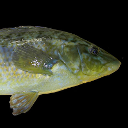Assembly
The BallGen_V1 assembly was submitted by National Institute of nutrition and seafood research on May 2016. The assembly is on scaffold level, consisting of 13,723 contigs assembled into 13,466 scaffolds. The N50 size is the length such that 50% of the assembled genome lies in blocks of the N50 size or longer. The N50 length for the contigs is 703,847 while the scaffold N50 is 794,648.
Gene annotation
The Ballan wrasse (Labrus bergylta) is a species of wrasse native to the northeastern Atlantic Ocean from Norway to Morocco, including the islands of Madeira, the Azores and the Canary Islands. They can be found at depths from 1 to 50 m (3.3 to 164.0 ft) amongst rocks, seaweed and reefs. It can grow to 65.9 cm (25.9 in) in total length (though most do not exceed 50 cm (20 in) standard length), and the greatest recorded weight of this species is 4.4 kg (9.7 lb). All Ballan wrasses are female for their first four to 14 years before a few change into males. Large Ballan wrasses are almost certainly male.This species is popular as a food fish in the Orkney Islands and in Galway, although it is not highly regarded as a food fish in much of the UK and Ireland.In recent years, it has become a popular catch-and-release target for sport fishermen using light fishing tackle, particularly those employing soft plastic lures.It can also be used to clean sea lice from Norwegian farmed salmon; the technique is also being developed in Scotland.This species can also be found in the aquarium trade.
The gene annotation process was carried out using a combination of protein-to-genome alignments, annotation mapping from a suitable reference species and RNA-seq alignments (where RNA-seq data with appropriate meta data were publicly available). For each candidate gene region, a selection process was applied to choose the most appropriate set of transcripts based on evolutionary distance, experimental evidence for the source data and quality of the alignments. Small ncRNAs were obtained using a combination of BLAST and Infernal/RNAfold. Pseudogenes were calculated by looking at genes with a large percentage of non-biological introns (introns of <10bp), where the gene was covered in repeats, or where the gene was single exon and evidence of a functional multi-exon paralog was found elsewhere in the genome. lincRNAs were generated via RNA-seq data where no evidence of protein homology or protein domains could be found in the transcript.
In accordance with the Fort Lauderdale Agreement, please check the publication status of the genome/assembly before publishing any genome-wide analyses using these data.
More information
General information about this species can be found in Wikipedia.
Statistics
Summary
| Assembly | BallGen_V1, INSDC Assembly GCA_900080235.1, May 2016 |
| Base Pairs | 805,480,521 |
| Golden Path Length | 805,480,521 |
| Annotation provider | Ensembl |
| Annotation method | Full genebuild |
| Genebuild started | May 2018 |
| Genebuild released | Jul 2018 |
| Genebuild last updated/patched | Mar 2020 |
| Database version | 115.1 |
Gene counts
| Coding genes | 27,393 |
| Non coding genes | 1,650 |
| Small non coding genes | 1,599 |
| Long non coding genes | 3 |
| Misc non coding genes | 48 |
| Pseudogenes | 44 |
| Gene transcripts | 40,572 |
Other
| Genscan gene predictions | 53,798 |
